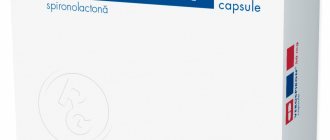Betahistine is a tablet drug. It is used to relieve symptoms that appear against the background of malfunctions of the vestibular apparatus associated with impaired functioning of the central nervous system.
Betahistine tablets, the instructions focus on this, are used to treat Meniere's syndrome. Typically, the disease is confirmed when problems with hearing function or coordination appear. Additional signs are frequent, causeless dizziness. In the acute stage, symptoms manifest as a stroke. If left untreated, a secondary attack can be life-threatening.
The drug is also used for symptomatic treatment of vestibular dizziness - vertigo. Its causes are most often inflammatory diseases of the inner ear, as well as traumatic brain injury, intoxication and metabolic disorders.
pharmachologic effect
Betahistine is a histamine created synthetically. Basically, the active substance of the drug is capable of engaging histamine H-1 and H-3 receptors (weak and strong antagonists) of the central nervous system. In this case we are referring to the receptors of the inner ear and vestibular nuclei.
Betahistine dihydrochloride affects blood flow, stimulating microcirculation and permeability of the capillaries of the inner ear. In addition, the active ingredient of this drug stabilizes the endolymph pressure in the cochlea and labyrinth.
Due to the fact that Betahistine is essentially an inhibitor of H-3 receptors in the nuclei of the vestibular apparatus, this drug has a pronounced effect on the central nervous system, stabilizing neuronal transmission in the neurons of the vestibular nucleus.
Betahistine, when taken correctly, can very quickly neutralize the symptoms of vestibular vertigo . The period of exposure to the active substance of this drug ranges from several minutes to 24 hours. Regular use of Betagistine under medical supervision will reduce the frequency and effectiveness of dizziness, reduce noise and ringing in the ears in patients, and also restore hearing if it worsens. The drug does not have a sedative effect and does not cause various coordination disorders. Does not affect the endocrine glands.
Betagistin-Teva 24 mg No. 30 tablet.
Instructions for medical use of the drug Betahistine-Teva Trade name Betahistine-Teva International nonproprietary name Betahistine Dosage form Tablets, 16 mg and 24 mg composition One tablet contains the active substance - betahistine hydrochloride 16 mg or 24 mg, excipients: povidone K90, microcrystalline cellulose , lactose monohydrate, colloidal silicon dioxide anhydrous, crospovidone, stearic acid Description Cylindrical tablets of white or almost white color, with a chamfer on both sides, with the imprint “B 16” on one side and a score on the other (for a dosage of 16 mg). Tablets are round, biconvex, white or whitish in color, with a score on one side (for a dosage of 24 mg). Pharmacotherapeutic group Other drugs for the treatment of diseases of the nervous system. Remedies for dizziness. Betahistine. ATC code N07CA01 Pharmacological properties Pharmacokinetics After oral administration, betahistine hydrochloride is absorbed quickly and completely. Plasma protein binding is low (less than 5%). Betagistine hydrochloride is rapidly metabolized in the liver to the inactive main metabolite, 2-pyridylacetic acid and dimethylbetagistine. The half-life is 3.5 hours. Excretion of betahistine hydrochloride is 90% through the kidneys in the form of the main metabolite. Pharmacodynamics Betahistine hydrochloride is a synthetic analogue of histamine. Acts on histamine H1 and H3 receptors of the inner ear and vestibular nuclei of the central nervous system. Improves microcirculation and permeability of capillaries of the inner ear, increases blood flow in the basilar arteries, normalizes endolymph pressure in the labyrinth and cochlea. Indications for use For the treatment of - Meniere's disease or Meniere's syndrome - vestibular dizziness of various origins (dizziness with nausea and vomiting, ringing in the ears, hearing loss) Method of administration and dosage Recommended initial dose - 24 mg per day (or 16 mg 2 times a day day) orally during or after meals. The daily dose can be increased to 48 mg. During the course of treatment, the dose is adjusted depending on the therapeutic effect. The duration of the course of treatment is determined by the attending physician individually. A stable therapeutic effect occurs after two weeks of treatment. The best results are observed after several months of treatment. Side effects Rarely - headache, drowsiness - increased intracranial pressure - feeling of heat - palpitations, tightness in the heart - gastrointestinal disorders: nausea, vomiting, heartburn, pain in the epigastric region, flatulence (these symptoms will be less pronounced if you take the drug during meals or reduce dosage) - exacerbation of a history of bronchial asthma, rash, urticaria, itching, anaphylactic reactions Contraindications - hypersensitivity to betahistine hydrochloride and/or to any of the components of the drug - pheochromocytoma - pregnancy and lactation - childhood and adolescence up to 18 years - galactose intolerance, Lapp lactase deficiency or glucose-galactose malabsorption With caution: - gastric ulcer - bronchial asthma - in patients with urticaria, rash or allergic rhinitis - severe hypotension Drug interactions The metabolism of betahistine is suppressed by drugs that inhibit monoamine oxidase (MAO), including subtype B (eg, selegiline). Since betahistine hydrochloride is a histamine analogue, simultaneous use of H1 antagonists may cause a mutual weakening of the effect of the active agents. Special instructions Caution should be exercised when prescribing the drug in patients with peptic ulcers (including a history), as dyspepsia may develop. Symptoms of hives, rashes, and allergic rhinitis may worsen when taking betahistine. Features of the influence on the ability to drive a vehicle or potentially dangerous mechanisms Due to the side effect of drowsiness, a decrease in the ability to drive a car and control machines is possible. Overdose Symptoms: dry mouth, nausea, vomiting, dyspepsia, ataxia, facial flushing, dizziness, increased heart rate, bronchial spasm and edema, and convulsions may also occur after taking very high doses. Treatment: symptomatic (gastric lavage, use of activated carbon). There is no specific antidote. Release form and packaging 10 tablets in a blister pack made of PVC film and aluminum foil. 3 or 6 contour packages together with instructions for medical use in the state and Russian languages are placed in a cardboard pack. Storage conditions Store at a temperature not exceeding 25ºС. Keep out of the reach of children! Shelf life: 3 years Do not use after expiration date. Conditions for dispensing from pharmacies By prescription, Germany Packer "Merkle GmbH", Germany Owner of the registration certificate "ratiopharm GmbH", Germany Address of the organization that accepts claims from consumers on the quality of products (products) in the territory of the Republic of Kazakhstan Ratiopharm Kazakhstan LLP, 050040, g Almaty, Al-Farabi Ave. 19, BC Nurly-Tau, 1B, office 603. Address of the organization on the territory of the Republic of Kazakhstan responsible for post-registration monitoring of the safety of the drug ratiopharm Kazakhstan LLP, 050040, Almaty, Ave. Al-Farabi 19, BC Nurly Tau, 1B, office 603.
Pharmacodynamics and pharmacokinetics
Betahistine is quickly and completely absorbed after oral administration of the drug in tablets. Peak plasma concentrations of the active substance of the drug are achieved approximately one hour after oral administration on an empty stomach. Subsequently, Betahistine binds to human plasma proteins, but it is worth noting a very low level of binding - less than 5%.
In blood plasma, the maximum concentration of the active substance is reached after approximately 60 minutes. It is excreted from the body as a result of metabolism by metabolization to inactive metabolites - 2-pyridylacetic acid (the main metabolite) and demethylbetagistine .
Almost complete elimination of the drug substances occurs within 24 hours, mainly through the kidneys (approximately 90%), the remaining 10% is excreted through the intestines and liver.
Pharmacological properties
Pharmacodynamics.
betahistine dihydrochloride is a synthetic analogue of histamine for oral use. The mechanism of action of betahistine has only been partially studied. There are several credible hypotheses that are supported by data from animal and human studies. Effect of betahistine on the histaminergic system. It has been established that betahistine partially exhibits agonistic activity towards H1 receptors, as well as antagonistic activity towards histamine H3 receptors in nervous tissue and has insignificant activity towards histamine H2 receptors. Betahistine increases the metabolism and release of histamine by blocking presynaptic H3 receptors and inducing a decrease in the number of corresponding H3 receptors.
Effect on increasing blood flow to the cochlear area, as well as to the entire brain. Pharmacological studies in animals have demonstrated improved blood circulation in the stria vascularis of the inner ear, possibly due to relaxation of the precapillary sphincters in the microcirculatory system of the inner ear. Betahistine also causes an increase in cerebral blood flow in the human body.
Promoting vestibular compensation. Betahistine accelerates the recovery of vestibular function after unilateral neurectomy in animals, accelerating and promoting the process of vestibular compensation. This effect is achieved by increasing the metabolism and release of histamine and is realized as a result of antagonism of H3 receptors. In humans, treatment with betahistine also reduced the time to recovery of vestibular function after neurectomy.
Influence on the activity of neurons in the vestibular nuclei. It has been established that betahistine has a dose-dependent inhibitory effect on the generation of peak potentials in neurons of the medial and lateral vestibular nuclei.
The pharmacodynamic properties of betahistine, as shown in animals, provide a positive therapeutic effect of the drug on the vestibular system.
The effectiveness of betahistine has been shown in studies in patients with vestibular vertigo and Meniere's disease, which was manifested by a decrease in the severity and frequency of dizziness attacks.
Pharmacokinetics
Suction. When administered orally, betahistine is rapidly and almost completely absorbed in all parts of the gastrointestinal tract. After absorption, the drug is quickly and almost completely metabolized to form the metabolite 2-pyridylacetic acid. The plasma concentration of betahistine is very low. Therefore, all pharmacokinetic analyzes are carried out by measuring the concentration of the metabolite 2-pyridylacetic acid in blood plasma and urine.
When taking the drug with food, Cmax of the drug is lower than when taken on an empty stomach. However, the complete absorption of betahistine is identical in both cases, which indicates that food intake only slows down the absorption process of the drug.
Distribution. The proportion of betahistine that binds to plasma proteins is less than 5%.
Biotransformation. After absorption, betahistine is quickly and almost completely metabolized into 2-pyridylacetic acid (which does not exhibit pharmacological activity). After taking betahistine orally, the Cmax of 2-pyridylacetic acid in the blood plasma and urine is reached 1 hour after taking the drug and decreases with a half-life of about 3.5 hours.
Excretion. 2-pyridylacetic acid is rapidly excreted in the urine. When taking the drug at a dose of 8–48 mg, about 85% of the initial dose is determined in the urine. Excretion of betahistine by the kidneys or feces is insignificant.
Linearity. The rate of recovery remains constant at oral doses of 8–48 mg, indicating linear pharmacokinetics of betahistine and suggesting that the metabolic pathway involved is unsaturable.
Indications for use of Betagistine
Indications for the use of Betahistine are as follows: treatment of Meniere's syndrome , as well as symptoms that may include dizziness, tinnitus, partial hearing loss, nausea, and loss of coordination.
Reference: Meniere's syndrome manifests itself in the form of vestibular and auditory disorders that have not previously been observed in humans. May develop as an acute stroke . Has a high probability of subsequent relapse.
Side effects
Along with the obvious beneficial effects, taking Betahistine can cause side effects.
Attention: not every patient taking this drug will experience discomfort or experience at least one of the side effects listed below.
Experts warn that side effects when taking any drug are not always interpreted in a negative way. As a rule, in most cases, any reaction may indicate the body's adaptation to a new drug, so before deciding to stop using the drug, you should consult your doctor.
Common side effects from taking Betahistine occur in one in ten patients who take this medicine. The list of the most common side effects includes symptoms such as:
- general poor health;
- stomach upset (occurs when taking the drug before meals, which is strictly contraindicated);
- headache (in this case, you should take a painkiller, according to the preliminary recommendation of a specialist);
- bloating or discomfort;
- allergic skin reactions, such as hives and rashes (if such reactions occur, use an antihistamine or apply moisturizer to problem areas of the skin).
If these recommendations do not help eliminate side effects, the patient must consult a doctor before taking the next dose of Betahistine.
Side effects
The following adverse reactions were observed in patients with the following frequencies: very often (≥1/10), often (≥1/100 to 1/10), uncommon (≥1/1000 to 1/100), rarely (≥1/100). 10,000 to 1/1000), very rare (1/10,000), frequency unknown (cannot be determined from available data).
From the digestive system: often - nausea and dyspepsia.
From the nervous system: often - headache.
In addition to those reported in clinical studies, the following side effects have been spontaneously reported during post-marketing use and are known from the scientific literature. The frequency cannot be determined from the available data, so it is classified as unknown.
Adverse reactions, the frequency of which is unknown.
From the immune system: hypersensitivity reactions, such as anaphylaxis.
From the gastrointestinal tract: complaints of minor stomach upsets (vomiting, gastrointestinal pain, bloating and flatulence). These side effects usually go away when the drug is taken with food or when the dose is reduced.
From the skin and subcutaneous tissue: hypersensitivity reactions of the skin and subcutaneous fat have been observed, in particular angioedema, rash, itching and urticaria.
Instructions for use of Betagistine (Method and dosage)
The medicine Betahistine must be taken strictly in accordance with the instructions.
Dosage for adults
Anti-dizziness tablets must be taken with food or after meals at a dosage of 8 or 16 mg three times a day during the initial stage of treatment with this drug.
Maintenance doses of the drug usually range from 24 to 48 mg per day at the discretion of the attending physician. The daily dose should not exceed 48 mg. The dosage can be adjusted taking into account the individual health characteristics of patients. Sometimes improvement may only be seen after several weeks of treatment.
Treatment of patients with liver, kidney and heart failure
For patients with liver failure, treatment with Betahistine should be prescribed after a thorough study. Treatment of patients with renal and heart failure is also prescribed.
Treatment of elderly patients
In old age, Betahistine should be used with caution, since in this population group there is a high probability of negative reactions from the body to the active and auxiliary substances included in the medicine.
Betahistine, instructions for use for children and adolescents
Betahistine tablets are not recommended for use in children and adolescents under the age of 18 due to the lack of data on the safety and effectiveness of the drug.
Taking medication
Positive results appear in the first days after starting treatment with the drug. After two weeks of use, a stable therapeutic effect is recorded. When treated with betahistine for several months, the condition of patients with Meniere's syndrome improves significantly.
Understanding what betahistine is prescribed for, you need to know how to take the tablets. The dosage is prescribed individually by the doctor, taking into account the patient’s condition. The maximum daily dose is 48 mg. Taking tablets is indicated during meals. 2-3 times a day. The recommended course duration is 2 - 3 months. Sometimes periodic treatment is carried out.
Correction during treatment is usually not required. The effectiveness of the drug decreases when combined with other antihistamines. Betahistine does not have sedative properties, so there are no restrictions regarding driving a car during treatment. It is also allowed to work on various complex mechanisms without any restrictions.
Overdose
General information on cases of overdose with Betahistine has not been reported. It is known that some patients experienced mild to moderate symptoms such as headache, nausea, drowsiness and abdominal pain when taking the drug at a dose of up to 640 mg.
Other symptoms of overdose: vomiting, dyspepsia , ataxia and convulsions .
More serious complications: seizures, pulmonary or cardiovascular complications have been observed in cases of intentional overdose of the drug, especially in combination with other drugs. There is no specific antidote, so in case of overdose with this medicine, gastric lavage is recommended within one hour after administration.
Contraindications
Absolute contraindications are hypersensitivity to the active substance and other components of the product. Treatment with the drug is not prescribed until adulthood. The drug is contraindicated during pregnancy and lactation, since there is no data on its effect on the fetus and newborn child. Betahistine should not be used if you are lactose intolerant. Caution should be exercised when prescribing medication when the following diseases are diagnosed:
- Peptic ulcer of the stomach or duodenum.
- Pheochromocytoma.
- Bronchial asthma.
It is not recommended to use betahistine, the instructions for use indicate this, in combination with antihistamines. In addition, it is recommended to refuse the product if:
- Hives.
- Arterial hypotension.
- Allergic rhinitis.
Since studies on the reaction to the drug in renal and hepatic failure have not been conducted, it is recommended to refuse treatment for these pathologies.
Betagistine's analogs
Level 4 ATX code matches:
Betagis
Stugeron
Betaserk
Betaver
Westinorm
Westicap
Tagista
Vestibo
Cinnarizine
Analogues of Betagistine, similar in composition and effective effect on the body:
- Alfaserk
- Asniton
- Betaver
- Betagistin-Nanolek
- Betagistin-SZ
- Betahistine hydrochloride
- Betahistine dihydrochloride
- Betaserk
- Vestibo
- Westicap
- Microzer
- Tagista
Interactions
In vivo studies examining the interaction of betahistine with other drugs have not been conducted. In vitro data suggest no inhibition of cytochrome p450 enzyme activity in vivo.
Data obtained in vitro indicate inhibition of betahistine metabolism by drugs that inhibit MAO activity, including MAO subtype B (for example, selegiline). Betahistine and MAO inhibitors (including selective MAO subtype B) should be used with caution.
Betahistine dihydrochloride is a histamine analog, and concomitant use of histamine H1 receptor antagonists may affect the effectiveness of either drug.
Reviews about Betagistine
As is the case with all medications, reviews of Betagistine are not always positive. On specialized forums you can often find reviews about the drug that indicate that the effect is not always stable. Therefore, most people suffering from chronic disorders of the cardiovascular system are forced to resort to taking these pills regularly. But this does not guarantee relief from headaches and dizziness.
However, there are many positive reviews. For example, several women wrote that during the onset of menopause they began to experience wild headaches and attacks of dizziness, which did not allow them to even slightly tilt their heads down, since at these moments they completely lost coordination. After prescribing Betahistine, these symptoms disappeared completely, clarity of mind and lightness appeared throughout the body.
Both positive and negative reviews indicate that this drug requires very careful use - for some disorders it can completely restore health, but for others, on the contrary, it will not have the expected effect, but will only reduce the manifestation of symptoms.
Note!
Description of the drug Betagistin-Teva table. 24mg No. 20 on this page is a simplified author’s version of the apteka911 website, created on the basis of the instructions for use.
Before purchasing or using the drug, you should consult your doctor and read the manufacturer's original instructions (attached to each package of the drug). Information about the drug is provided for informational purposes only and should not be used as a guide to self-medication. Only a doctor can decide to prescribe the drug, as well as determine the dose and methods of its use.
Betagistin price, where to buy
The price of Betahistine may vary and depends on the number of tablets in the package. For example, the price of Betagistin 24 mg No. 30 varies from 100 to 300 rubles, which, by the way, does not affect the demand for this drug. Many consumers believe that such a low cost of the drug is an additional plus to its obvious advantages.
- Online pharmacies in RussiaRussia
- Online pharmacies in UkraineUkraine
- Online pharmacies in KazakhstanKazakhstan
ZdravCity
- Betahistine tablets 24 mg 60 pcs. Ozon LLC
314 RUR order - Betahistine tablets 24 mg 30 pcs. Ozon LLC
RUB 176 order
- Betahistine Canon tablets 24 mg 20 pcs. CJSC Kanonpharma Production/CJSC Raduga Production
RUB 131 order
- Betahistine Canon tablets 24 mg 30 pcs. JSC Kanonpharma Production
112 rub. order
- Betahistine Canon tablets 16 mg 30 pcs. CJSC Kanonpharma Production/CJSC Raduga Production
111 rub. order
Pharmacy Dialogue
- Betahistine Canon tablets 16 mg No. 30Canonpharma Production
100 rub. order
- Betahistine Canon tablets 24 mg No. 30Canonpharma Production
106 rub. order
- Betagistine Canon (tab. 24 mg No. 20) Rainbow Production CJSC
128 rub. order
- Betahistine Canon (8 mg tablet No. 30)Canonpharma Production
78 RUR order
- Betahistine (16 mg tablet No. 30)Vertex
112 rub. order
show more
Pharmacy24
- Betahistine-KV 16 mg N30 tablets PAT "Kiev Vitamin Plant", Kiev, Ukraine
76 UAH. order - Betagistin-Teva 24 mg No. 20 tablets Merkle GmbH, Nimechchina
121 UAH order
- Betagistin-Teva 16 mg No. 30 tablets Merkle GmbH, Nimechchina
109 UAH order
- Betahistine-KV 8 mg N30 tablets PAT "Kiev Vitamin Plant", Kiev, Ukraine
55 UAH order
- Betagistin-KV 24 mg N30 tablets PAT "Kiev Vitamin Plant", Kiev, Ukraine
90 UAH order
PaniPharmacy
- Betahistine - KV table. 24 mg No. 30
92 UAH order
show more





